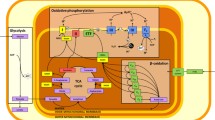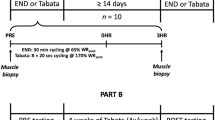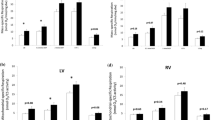Abstract
Purpose
To investigate within the one study potential molecular and cellular changes associated with mitochondrial biogenesis following 15 days of exposure to moderate hypoxia.
Methods
Eight males underwent a muscle biopsy before and after 15 days of hypoxia exposure (FiO2 = 0.140–0.154; ~ 2500–3200 m) in a hypoxic hotel. Mitochondrial respiration, citrate synthase (CS) activity, and the content of genes and proteins associated with mitochondrial biogenesis were investigated.
Results
Our main findings were the absence of significant changes in the mean values of CS activity, mitochondrial respiration in permeabilised fibers, or the content of genes and proteins associated with mitochondrial biogenesis, after 15 days of moderate normobaric hypoxia.
Conclusion
Our data provide evidence that 15 days of moderate normobaric hypoxia have negligible influence on skeletal muscle mitochondrial content and function, or genes and proteins content associated with mitochondrial biogenesis, in young recreationally active males. However, the increase in mitochondrial protease LON content after hypoxia exposure suggests the possibility of adaptations to optimise respiratory chain function under conditions of reduced O2 availability.





Similar content being viewed by others
Data availability
The datasets generated during and analysed during the current study are available from the corresponding author on reasonable request.
Abbreviations
- AMS:
-
Acute mountain sickness
- ATP:
-
Adenosine triphosphate
- BIOPS:
-
Biopsy preservation solution
- BMI:
-
Body Mass Index
- CI:
-
Confidence interval
- CI to CV:
-
Complex I–V
- COX:
-
Cytochrome c oxidase
- CS:
-
Citrate synthase
- E:
-
Electron transport system capacity
- ES:
-
Effect size
- ETC:
-
Electron transport chain
- FCCP:
-
Titrating carbonyl cyanide 4-(trifluoromethoxy) phenylhydrazone
- FiO2 :
-
Fractional inspired oxygen
- Hb:
-
Hemoglobin
- Hct:
-
Hematocrit
- HIF-1:
-
Hypoxia-inducible factor 1
- L:
-
Leak respiration
- LONP:
-
Lon Protease
- MIRO5:
-
Mitochondrial respiration medium
- P:
-
Oxidative phosphorylation capacity
- p53:
-
Tumor suppressor protein
- PGC-1α:
-
Peroxisome proliferator-activated receptor γ coactivator 1α
- Post:
-
After 15 days of hypoxic exposure
- Pre:
-
Before 15 days of hypoxic exposure
- ROX:
-
Residual oxygen consumption
- SaO2 :
-
Arterial blood saturation
- SD:
-
Standard Deviation
- SEM:
-
Standard Error
- SL:
-
Sea level
- TEM:
-
Transmission electron microscopy
- V̇O2peak :
-
Peak oxygen uptake
- Wpeak :
-
Peak power output
References
Arany Z, Foo SY, Ma Y, Ruas JL, Bommi-Reddy A, Girnun G, Cooper M, Laznik D, Chinsomboon J, Rangwala SM, Baek KH, Rosenzweig A, Spiegelman BM (2008) HIF-independent regulation of VEGF and angiogenesis by the transcriptional coactivator PGC-1alpha. Nature 451:1008–1012
Beidleman BA, Staab JE, Muza SR, Sawka MN (2017) Quantitative model of hematologic and plasma volume responses after ascent and acclimation to moderate to high altitude. Am J Physiol Regul Integr Comp Physiol 312:R265–R272
Bergstrom J (1975) Percutaneous needle biopsy of skeletal muscle in physiological and clinical research. Scand J Clin Lab Invest 35:609–616
Bota DA, Davis KJ (2002) Lon protease preferentially degrades oxidized mitochondrial aconitase by an ATP-stimulated mechanism. Nat Cell Biol 4:674–680
Brooks JT, Elvidge GP, Glenny L, Gleadle JM, Liu C, Ragoussis J, Smith TG, Talbot NP, Winchester L, Maxwell PH, Robbins PA (2009) Variations within oxygen-regulated gene expression in humans. J Appl Physiol 106:212–220
Butterfield GE, Gates J, Fleming S, Brooks GA, Sutton JR, Reeves JT (1992) Increased energy intake minimizes weight loss in men at high altitude. J Appl Physiol 72:1741–1748
Chapman RF, Stray-Gundersen J, Levine BD (1998) Individual variation in response to altitude training. J Appl Physiol 85:1448–1456
Chicco AJ, Le CH, Gnaiger E, Dreyer HC, Muyskens JB, D’Alessandro A et al (2018) Adaptive remodeling of skeletal muscle energy metabolism in high-altitude hypoxia: lessons from AltitudeOmics. J Biol Chem 293:6659–6671
Dzhalilova D, Makarova O (2020) Differences in tolerance to hypoxia: physiological, biochemical, and molecular-biological characteristic. Biomedicines 8:428. https://doi.org/10.3390/biomedicines8100428
Eaton SL, Roche SL, Llavero Hurtado M, Oldknow KJ, Farquharson C, Gillingwater TH, Wishart TM (2013) Total protein analysis as a reliable loading control for quantitative fluorescent Western blotting. PLoS ONE 8:e72457
Faiss R, Pialoux V, Sartori C, Faes C, Deriaz O, Millet GP (2013) Ventilation, oxidative stress, and nitric oxide in hypobaic versus normobaric hypoxia. Med Sci Sports Exerc 45:253–260
Ferrus L, Commenges D, Gire J, Varene P (1984) Respiratory water loss as a function of ventilatory or environmental factors. Respir Physiol 56:11–20
Fukuda R, Zhang H, Kim J, Shimoda L, Dang CV, Semenza GL (2007) HIF-1 regulates cytochrome oxidase subunits to optimise efficiency of respiration in hypoxic cells. Cell 129:111–122
Fusch C, Gfrorer W, Koch C, Thomas A, Grunert A, Moeller H (1996) Water turnover and body composition during long-term exposure to high altitude (4900–7600 m). J Appl Physiol 80:1118–1125
Green H, Sutton J, Cymerman A, Young P, Houston C (1989) Operation Everest II: adaptations in human skeletal muscle. J Appl Physiol 66:2454–2461
Green HJ, Roy B, Grant S, Hughson R, Burnett M, Otto C, Pipe A, McKenzie D, Johnson M (2000) Increases in submaximal cycling efficiency mediated by altitude acclimatization. J Appl Physiol 89:1189–1197
Höchli D, Schneiter T, Ferretti G, Howald H, Claassen H, Moia C, Atchou G, Belleri M, Veicsteinas A, Hoppeler H (1995) Loss of muscle oxidative capacity after an extreme endurance run: the Paris-Dakar foot-race. Int J Sports Med 16:343–346
Hoppeler H, Kleinert E, Schlegel C, Claassen H, Howald H, Kayar SR, Cerretelli P (1990) II. Morphological adaptations of human skeletal muscle to chronic hypoxia. Int J Sports Med 11:S3–S9
Howald H, Pette D, Simoneau JA, Uber A, Hoppeler H, Cerretelli P (1990) III. Effects of chronic hypoxia on muscle enzyme activities. Int J Sports Med 11:S10–S14
Jacobs RA, Siebenmann C, Hug M, Toigo M, Meinild AK, Lundby C (2012) Twenty-eight days at 3454-m altitude diminishes respiratory capacity but enhances efficiency in human skeletal muscle mitochondria. FASEB J 26:5192–5200
Jacobs RA, Boushel R, Wright-Paradis C, Calbet JA, Robach P, Gnaiger E, Lundby C (2013) Mitochondrial function in human skeletal muscle following high-altitude exposure. Exp Physiol 98:245–255
Jacobs RA, Lundby AM, Fenk S, Gehrig S, Siebenmann C, Fluck D, Kirk N, Hilty MP, Lundby C (2016) Twenty-eight days of exposure to 3454 m increases mitochondrial volume density in human skeletal muscle. J Physiol 594:1151–1166
Koumenis C, Alarcon R, Hammond E, Sutphin P, Hoffman W, Murphy M, Derr J, Taya Y, Lowe SW, Kastan M (2001) Regulation of p53 by hypoxia: dissociation of transcriptional repression and apoptosis from p53-dependent transactivation. Mol Cell Biol 21:1297–1310
Kruse J-P, Gu W (2009) Modes of p53 regulation. Cell 137:609–622
Larsen S, Nielsen J, Hansen CN, Nielsen LB, Wibrand F, Stride N, Schroder HD, Boushel R, Helge JW, Dela F, Hey-Mogensen M (2012) Biomarkers of mitochondrial content in skeletal muscle of healthy young human subjects. J Physiol 590:3349–3360
Leverve X (1998) Metabolic and nutritional consequences of chronic hypoxia. Clin Nutr 17:241–251
Levett DZ, Radford EJ, Menassa DA, Graber EF, Morash AJ, Hoppeler H, Clarke K, Martin DS, Ferguson-Smith AC, Montgomery HE, Grocott MP, Murray AJ, Caudwell Xtreme Everest Research G (2012) Acclimatization of skeletal muscle mitochondria to high-altitude hypoxia during an ascent of Everest. FASEB J 26:1431–1441
Levine M, Ensom MH (2001) Post hoc power analysis: an idea whose time has passed? Pharmacotherapy 21:405–409
Lin J, Handschin C, Spiegelman BM (2005) Metabolic control through the PGC-1 family of transcription coactivators. Cell Metab 1:361–370
Mizuno M, Savard GK, Areskog NH, Lundby C, Saltin B (2008) Skeletal muscle adaptations to prolonged exposure to extreme altitude: a role of physical activity? High Alt Med Biol 9:311–317
Pesta D, Gnaiger E (2012) High-resolution respirometry: OXPHOS protocols for human cells and permeabilized fibers from small biopsies of human muscle. Methods Mol Biol 810:25–58
Pinti M, Gibellini L, Nasi M, De Biasi S, Bortolotti CA, Iannone A, Cossarizza A (2016) Emerging role of Lon protease as a master regulator of mitochondrial functions. Biochim Biophys Acta 1857:1300–1306
Pugh LGCE (1964) Blood volume and haemoglobin concentration at altitudes above 18,000 ft. (5500 m). J Physiol 170:344–354
Puigserver P, Spiegelman BM (2003) Peroxisome proliferator-activated receptor-γ coactivator 1α (PGC-1α): transcriptional coactivator and metabolic regulator. Endocr Rev 24:78–90
Saleem A, Carter HN, Iqbal S, Hood DA (2011) Role of p53 within the regulatory network controlling muscle mitochondrial biogenesis. Exerc Sport Sci Rev 39:199–205
Scheffler IE (2001) A century of mitochondrial research: achievements and perspectives. Mitochondrion 1:3–31
Schlittler M, Gatterer H, Turner R, Regli IB, Woyke S, Strapazzon G et al (2021) J Physiol 599:1083–1096
Semenza GL (2007) Hypoxia-inducible factor 1 (HIF-1) pathway. Sci STKE 207:cm8
Sen N, Satija YK, Das S (2011) PGC-1α, a key modulator of p53, promotes cell survival upon metabolic stress. Mol Cell 44:621–634
Sermeus A, Michiels C (2011) Reciprocal influence of the p53 and the hypoxic pathways. Cell Death Dis 2:e164. https://doi.org/10.1038/cddis.2011.48
Siebenmann C, Robach P, Lundby C (2017) Regulation of blood volume in lowlanders exposed to high altitude. J Appl Physiol 123:957–966
Toledo FG, Menshikova EV, Azuma K, Radikova Z, Kelley CA, Ritov VB, Kelley DE (2008) Mitochondrial capacity in skeletal muscle is not stimulated by weight loss despite increase in insulin action and decreases in intramyocellular lipid content. Diabetes 57:987–994
Waypa GB, Smith KA, Schumacker PT (2016) O2 sensing, mitochondria and ROS signaling: the fog is lifting. Mol Aspects Med 47–48:76–89
Weil JV (2003) Variation in human ventilatory control-genetic influence on the hypoxic ventilatory response. Respir Physiol Neurobiol 135:239–246
Westerterp KR, Meijer EP, Rubbens M, Robach P, Richlet JP (2000) Operation Everest III: energy and water balance. Pflugers Arch- Eur J Physiol 439:483–488
Woods AL, Sharma AP, Garvican-Lewis LA, Saunders PU, Rice AJ, Thompson KG (2017) Four weeks of classical altitude training increases resting metabolic rate in highly trained middle-distance runners. IJSNEM 26:83–90
Young AJ, Karl JP, Berryman CE, Montain SJ, Beidleman BA, Pasiakos SM (2019) Variability in human plasma volume responses during altitude sojourn. Physiol Rep 7:e14051
Zhao Y, Wang M-Y, Hao K, Chen X-Q, Du J-Z (2013) CRHR1 mediates p53 transcription induced by high altitude hypoxia through ERK 1/2 signaling in rat hepatic cells. Peptides 44:8–14
Acknowledgements
The authors would like to acknowledge and thank all those who supervised participants while they stayed in the hypoxic hotel: Elise Brent, James Broatch, Remi Delfour-Peyrethon, Nir Eynon, Jackson Fyfe, Cian McGinley, and Sarah Voisin. We would also like to thank all the participants for volunteering for such a challenging project.
Funding
No funding was received for conducting this study.
Author information
Authors and Affiliations
Contributions
AF, FB, DJB: study design; AF, FB, AEL, DJB: sample acquisition; XY, JK, CG, RSFO, CPH: biochemical and data analyses; AF, XY, JK, CG, RSFO, CPH, AEL, DJB: data interpretation; AF, DJB: first draft of the manuscript; AF, CG, RSFO, CPH, AEL: editing of manuscript; AF, XY, JK, CG, RSFO, CPH, FB, AEL, DJB: manuscript approval.
Corresponding author
Ethics declarations
Conflict of interest
The authors have no relevant financial or non-financial interests to disclose.
Ethics approval
This research study was approved by the Victoria University Human Research Ethics Committee (HRET 10/220). All procedures conformed to the standards set by the 1964 Declaration of Helsinki and its later amendments.
Consent to participate
Informed consent was obtained from all individual participants included in the study.
Additional information
Communicated by Guido Ferretti
Publisher's Note
Springer Nature remains neutral with regard to jurisdictional claims in published maps and institutional affiliations.
Rights and permissions
About this article
Cite this article
Ferri, A., Yan, X., Kuang, J. et al. Fifteen days of moderate normobaric hypoxia does not affect mitochondrial function, and related genes and proteins, in healthy men. Eur J Appl Physiol 121, 2323–2336 (2021). https://doi.org/10.1007/s00421-021-04706-4
Received:
Accepted:
Published:
Issue Date:
DOI: https://doi.org/10.1007/s00421-021-04706-4




